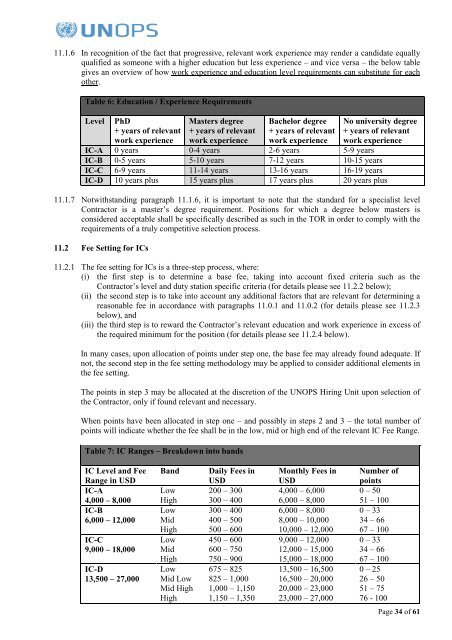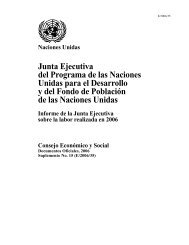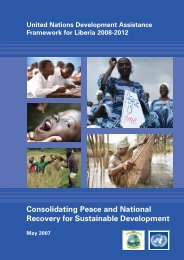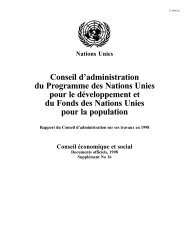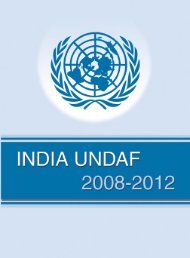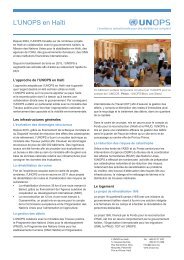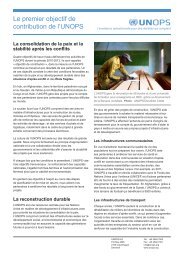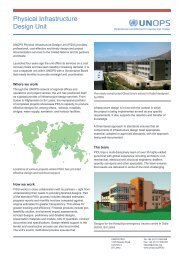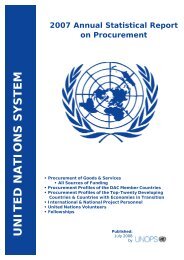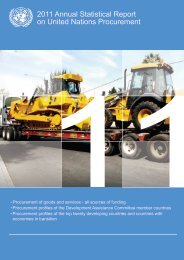ANNEX II - UNOPS
ANNEX II - UNOPS
ANNEX II - UNOPS
Create successful ePaper yourself
Turn your PDF publications into a flip-book with our unique Google optimized e-Paper software.
11.1.6 In recognition of the fact that progressive, relevant work experience may render a candidate equally<br />
qualified as someone with a higher education but less experience – and vice versa – the below table<br />
gives an overview of how work experience and education level requirements can substitute for each<br />
other.<br />
Table 6: Education / Experience Requirements<br />
Level<br />
PhD<br />
+ years of relevant<br />
work experience<br />
Masters degree<br />
+ years of relevant<br />
work experience<br />
Bachelor degree<br />
+ years of relevant<br />
work experience<br />
No university degree<br />
+ years of relevant<br />
work experience<br />
IC-A 0 years 0-4 years 2-6 years 5-9 years<br />
IC-B 0-5 years 5-10 years 7-12 years 10-15 years<br />
IC-C 6-9 years 11-14 years 13-16 years 16-19 years<br />
IC-D 10 years plus 15 years plus 17 years plus 20 years plus<br />
11.1.7 Notwithstanding paragraph 11.1.6, it is important to note that the standard for a specialist level<br />
Contractor is a master’s degree requirement. Positions for which a degree below masters is<br />
considered acceptable shall be specifically described as such in the TOR in order to comply with the<br />
requirements of a truly competitive selection process.<br />
11.2 Fee Setting for ICs<br />
11.2.1 The fee setting for ICs is a three-step process, where:<br />
(i) the first step is to determine a base fee, taking into account fixed criteria such as the<br />
Contractor’s level and duty station specific criteria (for details please see 11.2.2 below);<br />
(ii) the second step is to take into account any additional factors that are relevant for determining a<br />
reasonable fee in accordance with paragraphs 11.0.1 and 11.0.2 (for details please see 11.2.3<br />
below), and<br />
(iii) the third step is to reward the Contractor’s relevant education and work experience in excess of<br />
the required minimum for the position (for details please see 11.2.4 below).<br />
In many cases, upon allocation of points under step one, the base fee may already found adequate. If<br />
not, the second step in the fee setting methodology may be applied to consider additional elements in<br />
the fee setting.<br />
The points in step 3 may be allocated at the discretion of the <strong>UNOPS</strong> Hiring Unit upon selection of<br />
the Contractor, only if found relevant and necessary.<br />
When points have been allocated in step one – and possibly in steps 2 and 3 – the total number of<br />
points will indicate whether the fee shall be in the low, mid or high end of the relevant IC Fee Range.<br />
Table 7: IC Ranges – Breakdown into bands<br />
IC Level and Fee<br />
Range in USD<br />
IC-A<br />
4,000 – 8,000<br />
IC-B<br />
6,000 – 12,000<br />
IC-C<br />
9,000 – 18,000<br />
IC-D<br />
13,500 – 27,000<br />
Band<br />
Low<br />
High<br />
Low<br />
Mid<br />
High<br />
Low<br />
Mid<br />
High<br />
Low<br />
Mid Low<br />
Mid High<br />
High<br />
Daily Fees in<br />
USD<br />
200 – 300<br />
300 – 400<br />
300 – 400<br />
400 – 500<br />
500 – 600<br />
450 – 600<br />
600 – 750<br />
750 – 900<br />
675 – 825<br />
825 – 1,000<br />
1,000 – 1,150<br />
1,150 – 1,350<br />
Monthly Fees in<br />
USD<br />
4,000 – 6,000<br />
6,000 – 8,000<br />
6,000 – 8,000<br />
8,000 – 10,000<br />
10,000 – 12,000<br />
9,000 – 12,000<br />
12,000 – 15,000<br />
15,000 – 18,000<br />
13,500 – 16,500<br />
16,500 – 20,000<br />
20,000 – 23,000<br />
23,000 – 27,000<br />
Number of<br />
points<br />
0 – 50<br />
51 – 100<br />
0 – 33<br />
34 – 66<br />
67 – 100<br />
0 – 33<br />
34 – 66<br />
67 – 100<br />
0 – 25<br />
26 – 50<br />
51 – 75<br />
76 - 100<br />
Page 34 of 61


